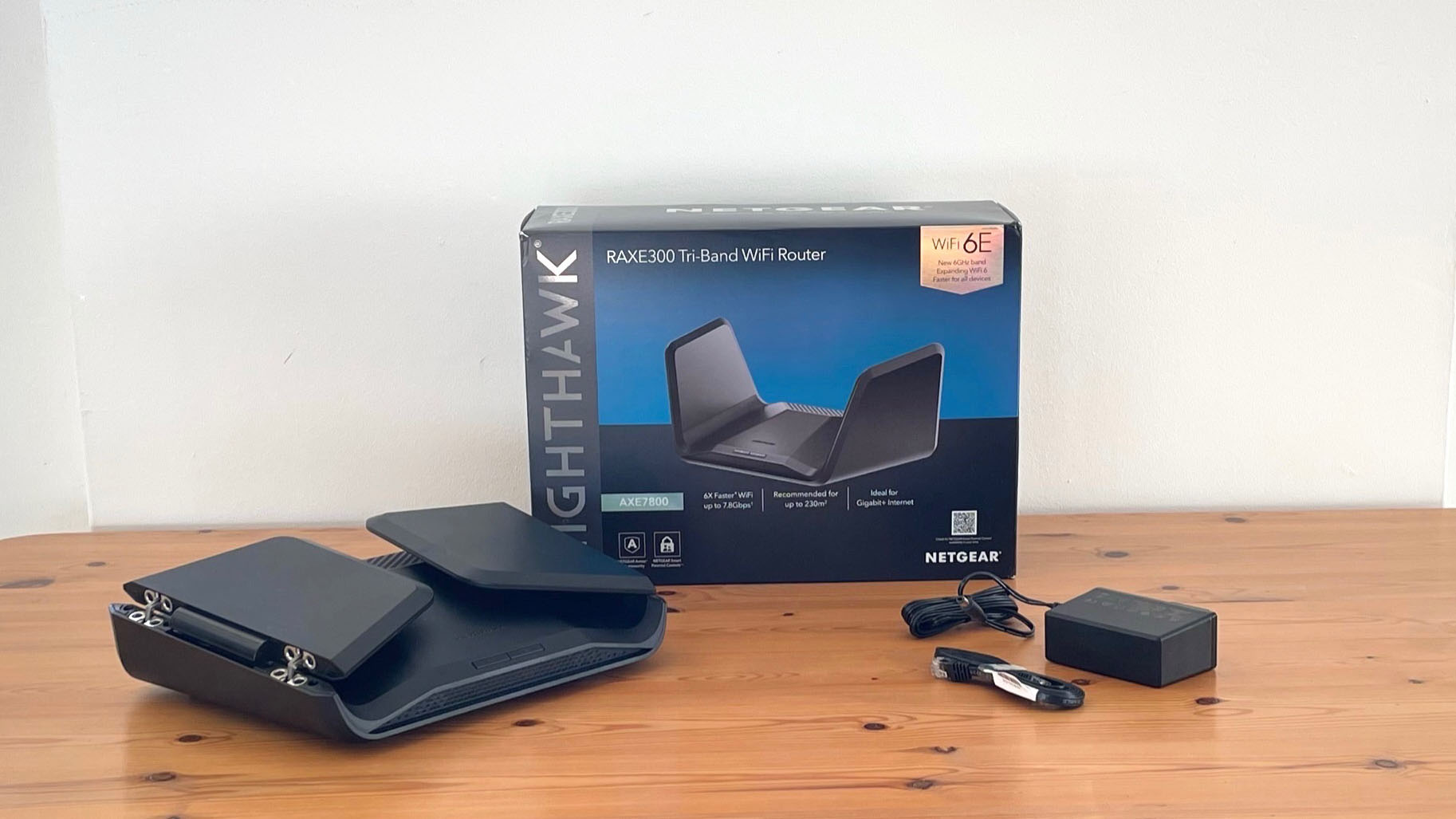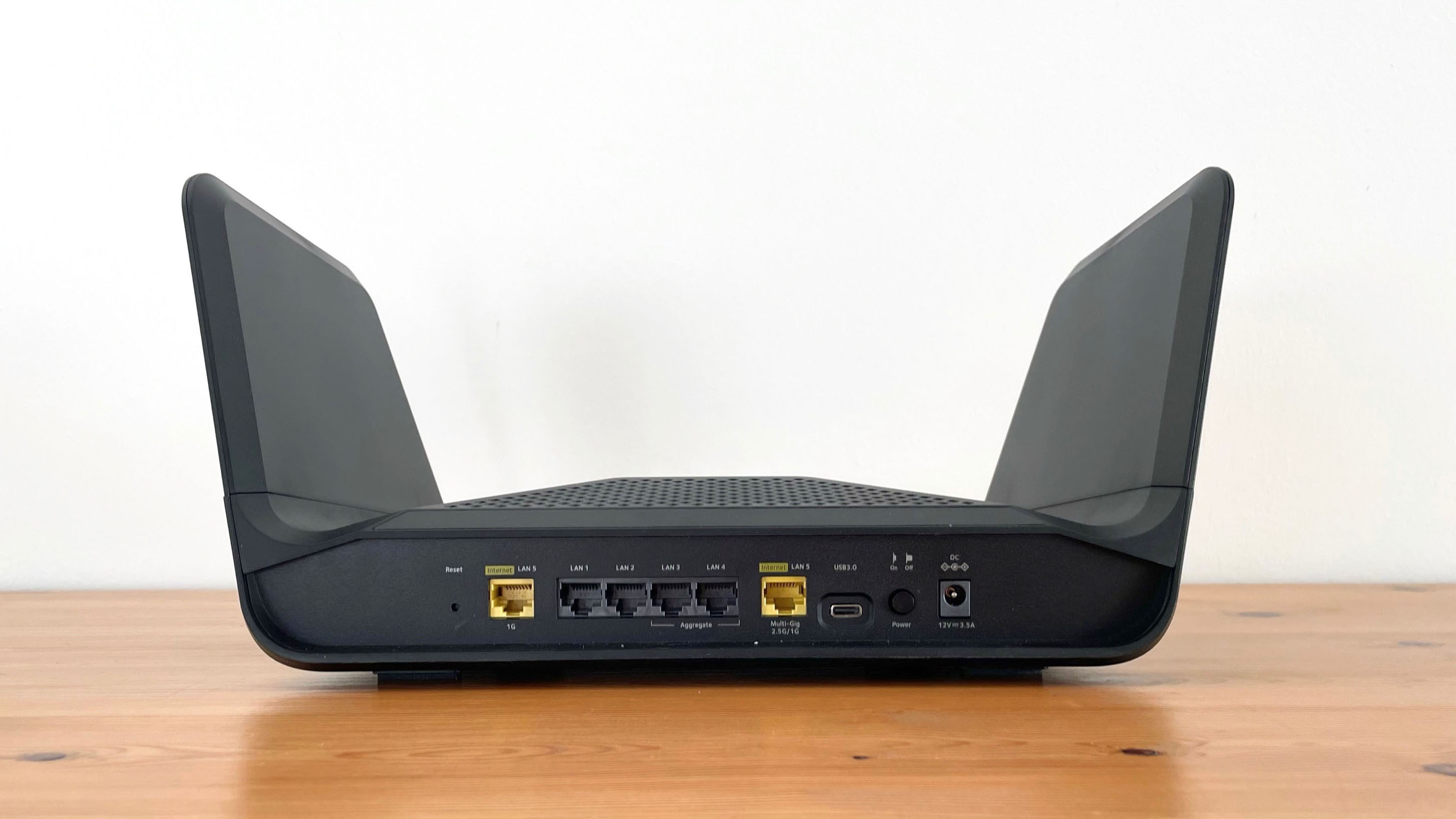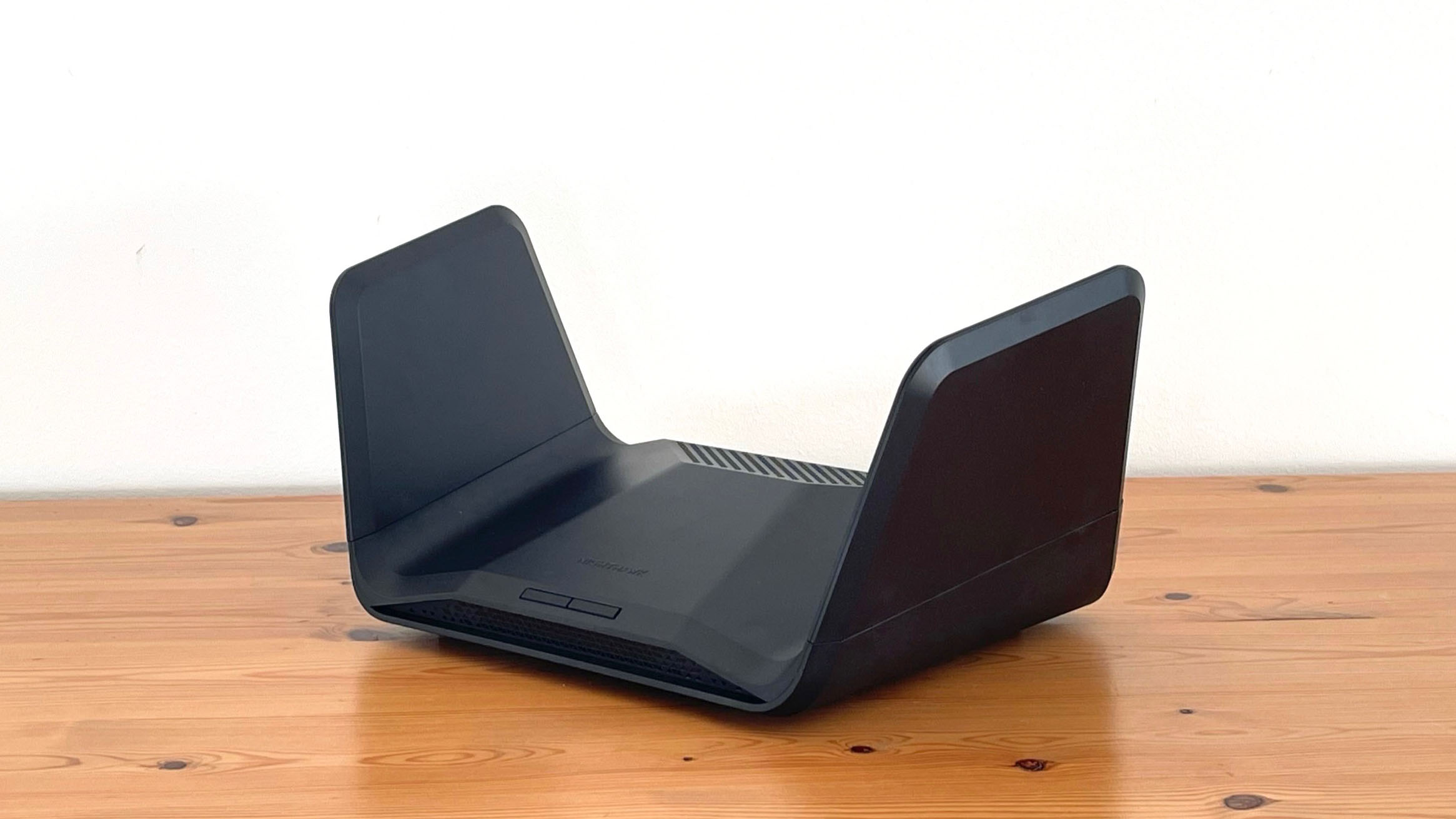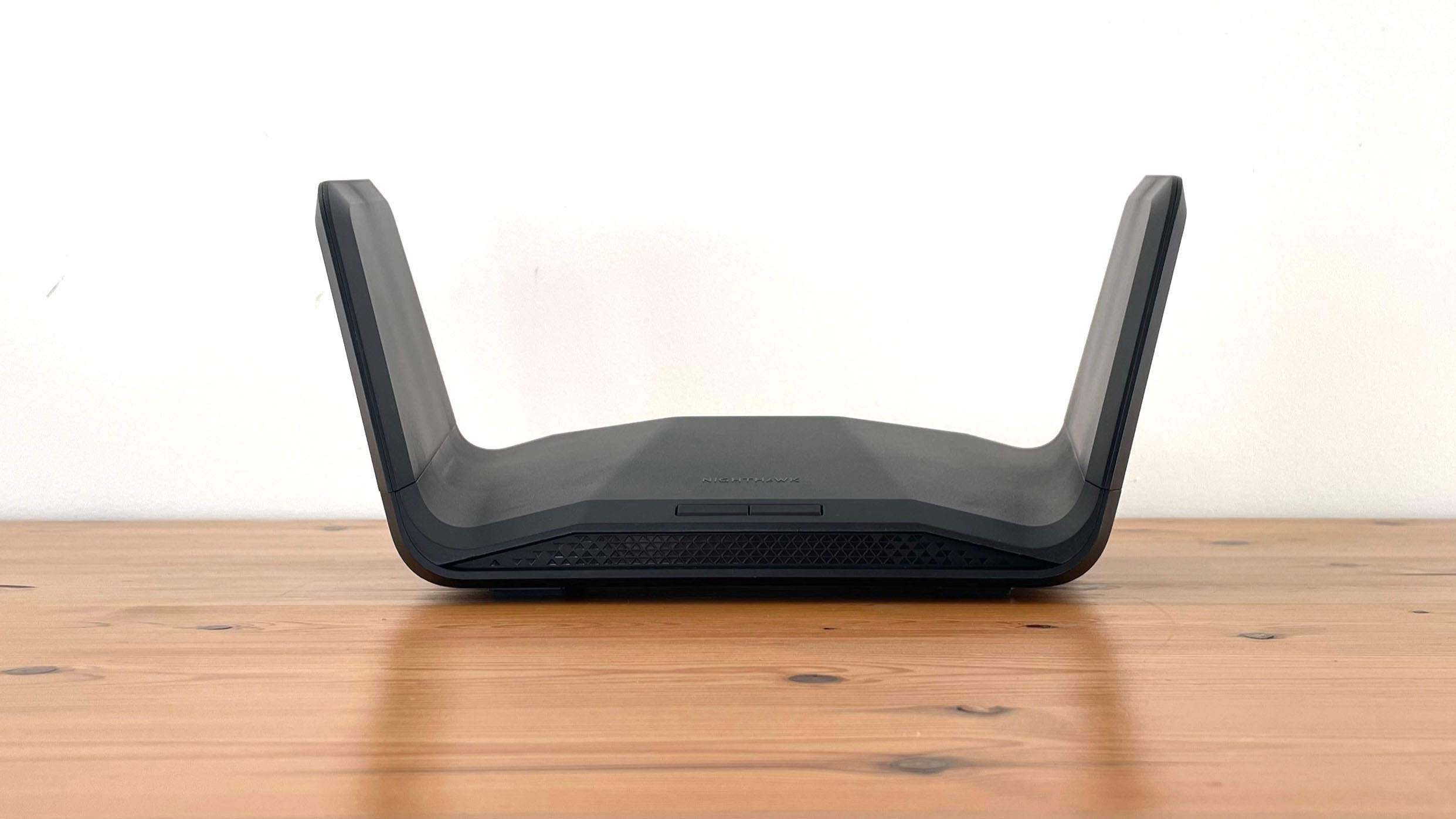Netgear Nighthawk RAXE300: One-minute review
Netgear is always quick to adopt the latest networking technologies, as it should given the price of its products, and has already introduced the latest Wi-Fi 6E technology into its high-end Orbi mesh systems. The Orbi systems are very much designed for larger homes, but if you don’t live in a Silicon Valley mega-mansion you can now get state-of-the-art Wi-Fi 6E from Netgear’s more conventional Nighthawk range of routers.
Things are a little confusing here, as there are four very similar Nighthawk models in the new RAXE range. Look out for that ‘E’ on the end, which denotes the use of Wi-Fi 6E as opposed to the earlier RAX range of routers which stick with straightforward Wi-Fi 6. The new Wi-Fi 6E models look virtually identical, sporting the eye-catching black, winged design used by previous Nighthawk models.
All four models also support tri-band Wi-Fi 6E, which adds the new 6.0GHz frequency to the existing 2.4GHz and 5.0GHz bands used by Wi-Fi 5 and Wi-Fi 6. However, the four RAXE models all offer different speeds and prices, ranging from 7.3Gbps up to a colossal 10.8Gbps.
We decided to opt for the mid-range Netgear Nighthawk RAXE300, a Wi-Fi 6 router that sneaks in at just under $400, with a top speed of 7.8Gbps that should be fast enough to stream 8K video or play the latest VR games with headsets. The Nighthawk RAXE300 also provides solid wired connectivity, with multiple Ethernet ports and even USB-C too. The Nighthawk app will get you started quickly and easily but, as we’ve seen before, the app is also a little basic and requires additional paid subscriptions for access to parental controls and other features.
Netgear Nighthawk RAXE300: Price and availability
- How much does it cost? $399.99 (£349.99, AU$699.00)
- Where is it available? Available now
- Where can you get it? Available in the US, the UK, and Australia
Netgear Nighthawk RAXE300: SPECS
Wireless Connectivity: tri- band WiFi 6E (2.4GHz + 5.0GHz + 6.0GHz)
Wi-Fi Speed: 7.8Gbps
Wired Connectivity: 1x Gigabit Ethernet (WAN), 1x 2.5 Gigabit Ethernet (WAN), 4x Gigabit Ethernet (LAN), 1x USB-C (3.0)
Processor: 1.7GHz, quad-core
Memory: 512GB
Storage: 256MB Flash
Dimensions: 170 x 315 x 208mm
Weight: 1.01kg
Alternatively, speed demons can go for the top-of-the-range Netgear Nighthawk RAXE500, which reaches a blazing 10.8Gbps and costs $599.99/£549.99/AU$1099.00. But, as mentioned, all the Nighthawk routers look virtually identical, so it’s important to pay close attention to the speeds they offer before buying.
The Nighthawk RAXE300 might seem to be a fairly expensive standalone router, costing $399.99/£349.99/AU$699.00. Even so, that’s still less than rival Wi-Fi 6E routers, such as Asus’ top-of-the-range Rapture GT-AXE11000. Customers in the US can save a little money by opting for the entry-level Nighthawk RAXE290, which is only slightly slower at 7.3Gbps. That model costs around $250 in the US, although it wasn’t available in other regions at the time of this review.

Netgear Nighthawk RAXE300: Design
- Eye-catching design
- Lots of Ethernet ports
- USB-C for shared storage
The Nighthawk routers are instantly recognizable, with a streamlined, low-profile design and prominent ‘wings’, which make them look like a Cylon battleship from Battlestar Galactica. It’s not just eye-candy, though, as the wings house six internal antennae, holding them up and away from the body of the router to beam the Wi-Fi signal as far as possible.

There are some impressive options for wired connections too, with no less than six Ethernet ports available on the back panel of the router. There are two ports, marked in yellow, that can be used for your Internet (WAN) connection, offering either Gigabit or 2.5 Gigabit speeds, along with four Gigabit Ethernet ports for wired (LAN) connections for devices such as a laptop or games console. It’s also possible to ‘aggregate’ two of these LAN ports, combining them to provide 2Gbps over Ethernet. The Netgear Nighthawk RAXE300 is also the first router we’ve seen that includes a USB-C port to connect a hard drive or other storage device that can be shared with other people on your home network.
Getting started is very straightforward, as the Nighthawk app allows you to simply scan a QR code on the base of the router to connect to its new Wi-Fi network. You can stick with the default network name (SSID) and password printed on the base of the router or create a new name and password for extra security. And, for simplicity, the app also allows the Nighthawk to use the same network name (SSID) and password as the network from your original router, so that you don’t have to change the log-in details on every device in your home.
But while the Nighthawk app is very easy to use, it is fairly basic, and attempts to sell you additional subscriptions to fill in for some of its missing features. The app’s parental controls are very limited, simply allowing you to pause Internet access to your kids’ devices. There are no scheduling features or content filters to block unsuitable web sites without paying for Netgear’s Smart Parental Controls service.
There’s a 30-day trial available in the app. But, after that, the service costs $7.99 per month (approx. £6.50 or AU$13.00) or $69.99 per year (approx. £57.50 or AU$112.00). That’s disappointing, given the Nighthawk’s high price – especially when some rival routers provide good parental controls at no extra cost. The app also provides a 30-day trial for Netgear’s Armor security service, with subscriptions costing $99.99 per year (approx. £82.00, or AU$160.00).

Netgear Nighthawk RAXE300: Performance
- Eye-catching wings do a good job
- Provide fast Wi-Fi
Netgear Nighthawk RAXE300: Benchmarks
Single, merged network
Ookla Speed Test
Within 5ft, no obstructions: 150Mbps/150Mbps
Within 30ft, three partition walls: 150Mbps/150Mbps
20GB Steam Download
Within 5ft, no obstructions: 19MB/s
Within 30ft, three partition walls: 19MB/s
As you’d expect, the state-of-the-art Netgear Nighthawk RAXE300 provides impressive performance, as well as good range that allows it to provide fast Wi-Fi even in the back office of our building, which is normally something of a Wi-Fi dead zone. Devices close by in the same room as the Nighthawk don’t show an obvious improvement, as the Nighthawk records the same speeds as our normal router, at 150Mbps for the Ookla speed test and 19MB/s for Steam downloads.
However, the Nighthawk’s eye-catching wings do a good job of firing its Wi-Fi into that back office, maintaining full speed for both Ookla and Steam as we pick up our laptop and wander along the hall to that back office.
Should I buy the Netgear Nighthawk RAXE300?

Buy it if…
Don’t buy it if…
Also consider
Netgear Nighthawk RAXE300: Report card
| Value | We can’t fault the hardware design or performance, but at this price the Nighthawk app needs to provide better parental controls – without a monthly subscription. | 3.5 / 5 |
| Design | The Nighthawk RAXE300 looks great, but it’s packed with the latest tech for both wi-fi and wired networking. | 4 / 5 |
| Performance | Wi-Fi 6E can go even faster, but 7.8Gbps is more than fast enough for most home broadband services. | 5 / 5 |
| Total | The Nighthawk RAXE300 provides slick design and impressive performance, but the hard-sell for additional subscriptions is disappointing at this price. | 4 / 5 |
- First reviewed November 2022
How we test
We pride ourselves on our independence and our rigorous review-testing process, offering up long-term attention to the products we review and making sure our reviews are updated and maintained – regardless of when a device was released, if you can still buy it, it’s on our radar.




